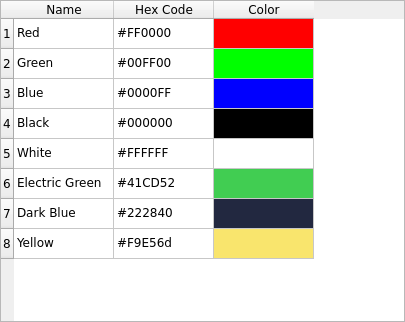Displaying Data Using a Table Widget¶
If you want to display data arranged in a table, use a QTableWidget to do
so, without dealing with much configuration.
Notice that using a QTableWidget is not the only path to display
information in tables. You can also create a data model and display it using
a QTableView, but that is not in the scope of this tutorial.
Note
This Widget is a ready-to-use version of something you can customize further on. To know more about the Model/View architecture in Qt, refer to its official documentation.
Import
QTableWidget,QTableWidgetItem, andQColorto display background colors:import sys from PySide6.QtGui import QColor from PySide6.QtWidgets import (QApplication, QTableWidget, QTableWidgetItem)
Create a simple data model containing the list of names and hex codes for different colors:
colors = [("Red", "#FF0000"), ("Green", "#00FF00"), ("Blue", "#0000FF"), ("Black", "#000000"), ("White", "#FFFFFF"), ("Electric Green", "#41CD52"), ("Dark Blue", "#222840"), ("Yellow", "#F9E56d")]
Define a function to translate the hex code into an RGB equivalent:
def get_rgb_from_hex(code): code_hex = code.replace("#", "") rgb = tuple(int(code_hex[i:i+2], 16) for i in (0, 2, 4)) return QColor.fromRgb(rgb[0], rgb[1], rgb[2])
Initialize the
QApplicationsingleton:app = QApplication()
Configure the
QTableWidgetto have a number of rows equivalent to the amount of items from thecolorsstructure, and a number of columns with the members of one color entry, plus one. You can set the column name using thesetHorizontalHeaderLabelsas described below:table = QTableWidget() table.setRowCount(len(colors)) table.setColumnCount(len(colors[0]) + 1) table.setHorizontalHeaderLabels(["Name", "Hex Code", "Color"])
Note
the reason of using
+ 1is to include a new column where we can display the color.Iterate the data structure, create the
QTableWidgetItemsinstances, and add them into the table using ax, ycoordinate. Here the data is being assigned row-per-row:for i, (name, code) in enumerate(colors): item_name = QTableWidgetItem(name) item_code = QTableWidgetItem(code) item_color = QTableWidgetItem() item_color.setBackground(get_rgb_from_hex(code)) table.setItem(i, 0, item_name) table.setItem(i, 1, item_code) table.setItem(i, 2, item_color)
Show the table and execute the
QApplication.table.show() sys.exit(app.exec())
The final application will look like this:

© 2022 The Qt Company Ltd. Documentation contributions included herein are the copyrights of their respective owners. The documentation provided herein is licensed under the terms of the GNU Free Documentation License version 1.3 as published by the Free Software Foundation. Qt and respective logos are trademarks of The Qt Company Ltd. in Finland and/or other countries worldwide. All other trademarks are property of their respective owners.
